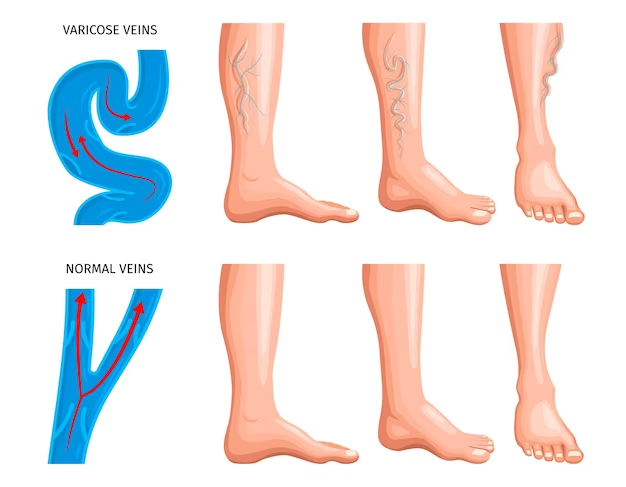Many people suffer from varicose veins, a common vascular ailment that lowers their quality of life. These twisted, swollen veins, which are frequently seen on the legs, are caused by weak or broken valves, which impair blood flow. In addition to being important from a cosmetic standpoint, treating varicose veins is essential for reducing associated symptoms, including discomfort and edema.
Clarivein has been a well-known and successful varicose vein therapy alternative in recent years. This minimally invasive surgery offers benefits including faster recovery and better cosmetic results by closing damaged veins using a combination of mechanical and chemical methods. When we examine the specifics, it becomes clear why Clarivein is becoming more and more well-known as a top option in the changing field of varicose vein therapy.
Scroll through the article to get access to a comprehensive guide for Clarivein Treatment by Vein Treatment Center.
What are Varicose Veins?
Varicose veins are mostly found in legs and are the swollen, twisted veins that frequently appear blue or dark purple. They develop as a result of weakening or injury to the vein’s valves, which control blood flow. Blood subsequently accumulates in the veins, causing them to enlarge and become noticeable on the skin’s surface.
Causes:
- Age: Vein valve deterioration may result from age naturally.
- Genetics: The chance of getting varicose veins is increased if there is a family history of the condition.
- Gender: Varicose veins are more common in women, particularly during pregnancy and other hormonal changes.
- Extended sitting or standing: Varicose veins can develop as a result of jobs or lifestyles that require prolonged sitting or standing.
Symptoms:
- Legs are hurting and swelling.
- Burning or itching feelings.
- Cramps in the legs, particularly after extended standing or sitting.
- Appearance of twisted, protruding veins.
Prevalence: About 10% to 15% of males and 20% to 25% of females suffer from varicose veins, a prevalent medical problem. As people age, the prevalence tends to rise, and other risk factors include obesity and pregnancy.
Overview of Clarivein Treatment:
With Clarivein, you may treat varicose veins with minimal invasiveness by closing the afflicted veins using a combination of chemical and mechanical techniques. In the process:
- The vein is used to place a catheter.
- The vein wall is damaged by the catheter’s mechanical rotation.
- A sclerosing agent is dispensed concurrently, which causes the vein to collapse and shut.
Because it is usually administered as an outpatient procedure without the need for a surgical incision, this therapy is regarded as minimally invasive.
Benefits of Clarivein:
- Reduced Recovery Time: Patients can return to their regular activities sooner thanks to clarivon, which frequently enables a speedier recovery than standard surgical techniques.
- Reduced Complication Risk: Because Clarivein is minimally invasive, there is a decreased chance of problems including infection and heavy bleeding, which are linked to open surgical treatments.
- Better Cosmetic Results: Compared to operations with bigger incisions, clariverine leaves little to no scarring, which improves the cosmetic outcomes.
Many people looking for relief from varicose veins find Clarivein to be an intriguing alternative since it provides a less intrusive solution with various advantages when compared to standard treatments.
Candidates for Clarivein:
Appropriate candidates are defined as follows:
- Those with symptomatic varicose veins: Those who feel pain, edema, or discomfort as a result of their veins.
- Patients who are looking for a less intrusive surgical option choose minimally invasive treatment.
- Those who have reasonable expectations for the results and the necessity of future follow-up meetings are said to have realistic expectations.
One needs to consider the following factors before going ahead with the treatment:
- Pregnancy: Although Clarivein is usually safe, it might not be advised for expectant mothers. In these situations, speaking with a healthcare professional is essential.
- Significant problems: Patients requiring alternate therapies may have significant venous problems.
- Medical History: Before receiving Clarivein, patients with certain medical disorders or allergies may need to give it significant thought.
The Clarivein Procedure: Step-by-Step:
The varicose vein treatment requires a lot of steps to be dealt with for a perfect and safe surgery.
Preparing for the Procedure:
Consultation:
- A patient has a comprehensive consultation with a healthcare professional.
- Medical history, symptoms, and expectations are discussed.
Visualization:
- The afflicted veins may be seen using ultrasound imaging.
- Considering the ultrasound results while formulating a treatment plan.
Steps in Treatment:
Regional Anesthesia:
- A local anesthetic is used to numb the treatment region.
- guarantees the patient’s comfort throughout the process.
Insertion of Catheters:
- A little puncture or incision is created close to the vein of interest.
- Under ultrasound guidance, a catheter is placed into the afflicted vein.
Rotation mechanically:
- The vein wall is mechanically disrupted by the catheter’s spinning tip.
- The sclerosing agent is distributed uniformly thanks to this rotation.
Agent Sclerosing Dispersion:
- Through the catheter, a sclerosing agent is administered concurrently with mechanical rotation.
- The treated vein becomes irritated and closes as a result of the sclerosing agent.
Closure of Veins:
- The treated vein closes as a result of both chemical closure and mechanical disruption.
- Healthy veins get the blood’s rerouting.
Following Procedure Observation:
- To make sure the patient is stable, a quick check is performed.
- It could be suggested to use compression stockings to speed up the healing process.
Resuming Regular Activities:
- After the treatment, patients may usually get back to their regular activities quickly.
- You might have to limit intense exercise for a little while.
Recovery:
The best method for recovery remains in two aspects, one being the most basic one, which is good hydration, and the other being elevation of the legs. The elevation of the legs with proper intervals in the form of an exercise can lessen the pain and swelling, but make sure you don’t over-do it or make it intense.
Post-Procedure Care:
Recheck Appointments:
- Arrange follow-up meetings to assess progress.
- It could be suggested to schedule several sessions to get the best outcomes.
Compression stockings: Compression stockings can be worn as per the direction of the doctor and can help accelerate the healing process.
Walking and physical activity: Moderate walking (definitely not very fast or slow) can improve blood flow and lower the risk of blood clots. Avoid intense workouts, as they might have long-term effects.
Follow-up appointments: Make sure to track development and address any problems; schedule routine follow-up visits with your healthcare professional.
Note: Depending on the unique features of each patient, the severity of varicose veins, and the preferences of the healthcare professional, the precise procedures and protocols may change. To guarantee a good recovery, patients should adhere to the pre- and post-procedure instructions provided by their healthcare professional.
Comparative Analysis: Clarivein vs. Other Treatments:
Traditional Surgery Against Clarivein:
Benefits of Clarivein:
- Minimally intrusive, requiring no big cuts.
- Decreased possibility of difficulties.
- Quicker time to recuperate.
Benefits of Conventional Surgery:
- Maybe more suited for serious situations.
- Vein closure occurs instantly.
Endovenous Laser Ablation (EVLA) against Clarivein:
Benefits of clarivein
- There is no chance of heat-related issues.
- Ideal for people with problems with skin pigmentation.
Benefits of EVLA:
- Maybe a little bit faster.
- Reduced pain and bruises.
Clarivein becomes a suitable treatment in the following circumstances:
- Patients Seeking Less Intrusive Options: For individuals who would like to take a less intrusive method, Clarivein is a great option.
- Skin Sensitivity: For individuals who have a history of keloid scarring or worry about their skin’s pigmentation, clarivein may be recommended over EVLA.
- Patients with Allergies to Laser Components: Clarivein offers an option for patients who have allergies to components used in laser treatments.
The decision between Clarivein and alternative therapies ultimately comes down to the unique characteristics of each patient, the degree of varicose veins, and the patient’s and the doctor’s preferences.
Addressing Concerns and FAQs:
A patient typically finds the following to be concerning:
Pain during the operation: Because Clarivein is a minimally invasive surgery, it is intended to be quite painless. The treatment region is usually numbed with a local anesthetic to reduce pain.
Treatment effectiveness: Varicose vein closure has been demonstrated with Clarivein. Individual outcomes, however, can differ, and several sessions might be necessary to achieve the best results.
Safety: Clarivein is thought to be safe in most cases; however, difficulties and dangers might arise with any medical procedure. These will be covered by your healthcare practitioner during the consultation.
FAQs
- What is the duration of the procedure?
Depending on how much therapy is required, clarivein procedures are often completed in less than an hour.
- Is Clarivein appropriate for all kinds of vein varicosities?
Although Clarivein works well in many situations, your doctor will determine if it’s the right choice for you depending on the particulars of your varicose veins.
- When can I get back to my regular routine?
After using Clarivein, patients may usually return to their regular activities, but they might need to refrain from intense exertion for a short while.
New Developments and Trends:
The new developments and trends in this field can come in the form of less invasive therapies, just like Clarivein. These treatments are being looked forward to and made more available as endovenous techniques. Moreover, another development can be the customization of care, which will be entirely based upon the needs of the patient and their traits. Customization has more scope to become more common, which would then lead to better results just via the medication and hence a lesser need for sessions.
Clarivein in the Changing Environment:
It is true that technology has no bar, and there might come a stage where there is an even more patient-friendly treatment compared to the Clarivein treatment.
With the factor of attention to detail, there are chances that it would reduce invasiveness and improve the overall patient experience.
So one thing to keep in mind is that individuals who are looking for the best solutions for their specific needs definitely need to stay informed about new advancements, but make sure to consult the doctors before making decisions.
Final Words
If you are seeking varicose vein treatment, you need to be well aware of the procedure and their personal capabilities before stepping in. As for the clarivein treatment, it is patient-friendly with comparatively less intrusion than other treatments.
The field of treating varicose veins is changing, and Clarivein is a big step forward in offering efficient, less invasive procedures. If you want to get treated for varicose veins in general, consult with healthcare experts at specialized varicose vein centres for customized advice and treatment plans. These professionals can help people make decisions and guarantee the best course of action for their particular requirements and circumstances. Click here to get access to the top varicose vein clinic in Beverly Hills and to varicose vein testing in Los Angeles.




